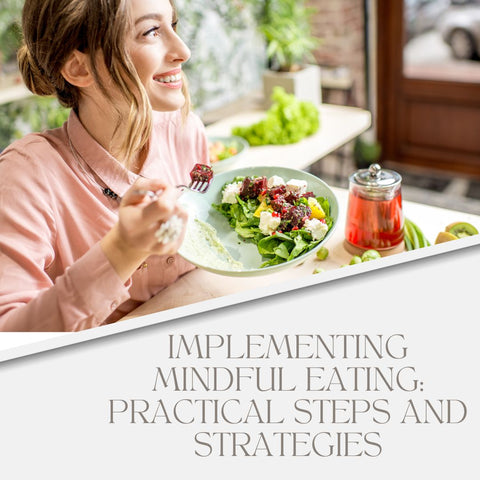Starting a mindful eating journey can help you overcome your food cravings and develop a healthier relationship with food. This blog is a step-by-step guide to help you get through this journey.
Foundations of Mindful Eating: Understanding the Basics

At its core, mindful eating entails paying complete attention to the experience of eating and drinking, both internally and externally. Here are the foundational principles that will help you understand the basics of mindful eating.
-
Being Present: Mindful eating entails paying complete attention to the present moment, focusing on the sensory experience of eating without distractions from thoughts, emotions, or external stimuli.
-
Engaging the Senses: As you eat, take note of the colours, textures, smells, tastes, and sounds of your food, savouring each bite with mindfulness.
-
Observing Without Judgement: Eat with a sense of curiosity, openness, and nonjudgment. Be aware of any thoughts or feelings that arise without categorising them as positive or negative.
-
Acceptance: Practice self-compassion and acceptance of yourself and your eating experiences, remembering that all eating experiences are opportunities for learning and growth.
-
Eating Slowly: Take your time with each bite, chewing thoroughly and savouring the flavours and textures of your food.
-
Tuning into Hunger and Fullness: Pay attention to your body's hunger and fullness cues, eating only when you are physically hungry and stopping when you are satisfied but not overfull.
-
Eating with Intention and Purpose: Choose foods that nourish your body while also reflecting your values and preferences.
-
Emotional Eating: Be aware of any emotional triggers or cues that may affect your eating habits, such as stress, boredom, or loneliness.
-
Mindful Responses: Rather than reacting impulsively to emotional triggers with food, try deep breathing, journaling, or engaging in self-care activities.
-
Gratitude Practice: Express gratitude for the food on your plate, acknowledging the time and resources that went into its preparation and distribution.
-
Appreciating Food: Take a moment to appreciate the flavours, aromas, and nourishment that each meal offers, and express gratitude for the abundance of food available to you.
-
Mindful Living: Apply mindfulness principles beyond eating to other aspects of your life, such as physical activity, relationships, work, and self-care.
-
Bringing Awareness to Daily Activities: Incorporate mindfulness into everyday activities such as walking, cooking, cleaning, and interacting with others, cultivating a sense of presence and connection in each moment.
The Pillars of Mindful Eating: Awareness, Presence, and Appreciation
The pillars of mindful eating—awareness, presence, and appreciation—form the basis for a healthy and nourishing relationship with food. Let us examine each pillar:
-
Awareness:
-
Pay close attention to the sensory experience of eating, such as the flavour, texture, aroma, and appearance of food.
-
Listen to your body's signals of hunger, fullness, and satisfaction to determine when you are truly hungry versus eating out of habit or emotion.
-
Consider your surroundings, the environment in which you are eating, and any outside influences on your eating habits.
2. Presence:
-
Cultivate presence by paying attention to the present moment and letting go of distractions and preoccupations.
-
Engage fully in the act of eating, paying attention to each bite and savouring the moment without rushing or multitasking.
-
Extend your presence during food preparation and cooking, enjoying the ingredients and the process of creating nutritious meals.
3. Appreciation:
-
Cultivate gratitude for the abundance of food available to you, and recognise the effort and resources that went into its production.
-
Recognise the nourishment and sustenance that food brings to your body, mind, and spirit.
-
Enjoy the flavours, textures, and aromas of food while expressing gratitude for the richness of the dining experience.
By incorporating awareness, presence, and appreciation into your eating habits, you can develop a stronger connection to food, increase your enjoyment of meals, and foster a healthier relationship with eating and nourishment.
Decoding the Hunger and Craving Signals: Learning to Listen
Decoding hunger and craving signals is an important aspect of mindful eating because it allows you to differentiate between physical hunger, emotional hunger, and cravings. Here's how to learn to listen to your body's cues, including physical hunger, emotional hunger, cravings, mindful eating, journaling and reflection, self-compassion, and understanding. Learning to listen to your body's hunger and craving signals with mindfulness and awareness will help you develop a healthier relationship with food, improve your eating habits, and better meet your nutritional and emotional needs.
Mindful Eating vs. Emotional Eating: Identifying the Difference
Mindful eating and emotional eating are two distinct approaches to food consumption, each with unique characteristics and effects on well-being. Here's how to tell the differences between them:
Mindful Eating:
-
Mindful eating entails being fully present and attentive to the eating experience, with an emphasis on the sensory aspects of food such as taste, texture, and aroma. There is a greater awareness of the physical sensations associated with hunger and fullness, which enables more deliberate food choices and portion control.
-
Mindful eating promotes a nonjudgmental approach to food and eating habits, without categorising foods as "good" or "bad." There is an air of curiosity and openness about the eating experience, with a focus on acceptance and self-compassion.
-
Meals are approached with intention and purpose, taking into account factors such as hunger, nutritional requirements, and individual preferences. Food choices are made with intention, based on internal cues of hunger and satiety rather than external influences or emotional stimuli.
-
Mindful eaters take the time to savour each bite of food, enjoying the flavours, textures, and aromas. Eating is a pleasurable and satisfying experience when done without distractions or mindless consumption.
Emotional Eating:
-
Emotional eating is defined as eating in response to emotional states such as stress, boredom, sadness, or anxiety rather than physical hunger. Food acts as a coping mechanism, soothing or distracting from unpleasant emotions and providing temporary comfort or relief.
-
Emotional eating often involves mindless or automatic consumption of food, with little awareness of the quantity or quality of food being consumed. Eating may occur impulsively in response to emotional triggers, without regard for nutritional requirements or hunger levels.
-
Cravings during emotional eating are frequently for specific comfort foods high in sugar, fat, or salt, which provide a temporary mood boost or sense of comfort. Food preferences are influenced more by emotional needs and cravings than nutritional considerations.
-
Following episodes of emotional eating, people may feel guilty, ashamed, or regret about their food choices, which can lead to a vicious cycle of negative emotions and self-criticism.
Implementing Mindful Eating: Practical Steps and Strategies

Mindful eating involves incorporating mindfulness practices into your daily eating habits. Here are some practical steps and strategies for incorporating mindful eating into your life, including creating a mindful environment, engaging your senses, practicing mindful eating techniques, tuning into your body, practicing gratitude, and cultivating mindful habits. By incorporating these simple steps and strategies into your daily routine, you can cultivate a more mindful approach to eating, resulting in increased enjoyment, satisfaction, and well-being in your relationship with food.
Daily Mindfulness Exercises for Meal Times
Incorporating daily mindfulness exercises into mealtimes can help you develop a stronger connection with your food and eating experience. Mindful breathing, five senses check-in, gratitude practice, slow and mindful eating, mindful conversation, reflection on nourishment, and practice moderation are some simple mindfulness exercises to do while eating.
Navigating Food Cravings with Mindful Techniques
Navigating food cravings with mindful techniques entails becoming aware of them without judgement and responding to them in a way that respects your body's needs while also taking into account your overall well-being. Pause and observe, mindful breathing, investigating the craving, practice acceptance, choosing mindfully, redirecting your attention, savouring the experience, practicing self-compassion, learning from the experience, and cultivating balance are some mindful techniques that can help you navigate food cravings. By incorporating these mindful techniques into your approach to food cravings, you can cultivate a healthier relationship with food and eating, honouring your body's needs while also practicing self-awareness and self-care.
Creating a Mindful Kitchen: Setting the Stage for Success
Creating a mindful kitchen entails arranging your cooking and eating areas to encourage mindfulness practices and healthy habits. Some tips for creating a mindful kitchen include decluttering and organising, cultivating presence, practicing gratitude, stocking mindful ingredients, mindful cooking, creating a nourishing environment, fostering connection, and practicing mindful eating. Creating a mindful kitchen environment allows you to cultivate a stronger sense of presence, gratitude, and connection to your food and eating experiences, which promotes overall well-being and healthy habits.
Advanced Mindful Eating Practices: Deepening Your Journey

Advanced mindful eating practices entail increasing your awareness and connection to the eating experience, as well as investigating the deeper meanings and insights that come from mindful eating. Some advanced practices to deepen your mindful eating journey include mindful eating retreats or workshops, mindful food preparation, mindful eating meditation, mindful movement and eating, mindful eating journaling, mindful community and support, mindful eating challenges, and mindful lifestyle integration. By incorporating these advanced mindful eating practices into your life, you can deepen your journey of self-discovery, nourishment, and transformation while also cultivating greater awareness, peace, and joy in your relationship with food and eating.
The Role of Meditation in Enhancing Mindful Eating
Meditation contributes significantly to mindful eating by cultivating awareness, presence, and nonjudgmental acceptance of the eating experience. Here are some ways meditation can help with mindful eating: cultivating awareness, increasing presence, developing nonjudgmental acceptance, managing cravings and emotional eating, promoting intuitive eating, and reducing stress.
Joining a Mindful Eating Community: Support and Sharing
Joining a mindful eating community can be a rewarding experience, offering you valuable support and opportunities to share. Here are some of the benefits of joining such a community: a supportive environment, accountability, learning and growth, practical tips and advice, connection and belonging, inspiration and motivation, and opportunities to share.
Mindful Eating in Action: Real-world Applications and Success Stories
Incorporating meditation into your daily routine can significantly improve your ability to practise mindful eating, leading to greater enjoyment, satisfaction, and balance in your relationship with food. Regular meditation, whether in the form of formal seated meditation practices or informal mindfulness exercises, can assist you on your path to mindful living and wellbeing.
Embracing a Mindful Eating Lifestyle: Beyond the Basics

These real-world success stories show how mindful eating can promote overall well-being, improve eating habits, and foster a healthier relationship with food. By incorporating mindfulness practices into your daily eating habits, you can reap the benefits of mindful eating in your life.
Mindful Grocery Shopping: Making Conscious Choices
Mindful grocery shopping entails making deliberate decisions about which foods to purchase, taking into account factors such as nutritional value, sustainability, and personal preferences. Create a shopping list, shop with intention, choose fresh, whole foods, promote sustainable practices, make mindful decisions, practise moderation, listen to your body, and express gratitude. By practicing mindful grocery shopping, you can make informed decisions that nourish your body, support sustainable practices, and are consistent with your values and preferences. Over time, mindful shopping habits can help you live a healthier lifestyle and have a more balanced relationship with food.
Integrating Mindfulness into Cooking and Food Preparation
Integrating mindfulness into cooking and food preparation entails bringing complete awareness, presence, and intention to the culinary experience. Begin with mindful preparation, practise present-moment awareness, cultivate gratitude, savour the experience, accept imperfection, cook with intention, clean mindfully, and enjoy mindful eating. By incorporating mindfulness into cooking and food preparation, you can turn the culinary experience into a mindful practice that benefits not only the body but also the mind and spirit.
Leveraging Technology: Apps and Resources to Aid Your Practice
Using technology can help you improve your mindfulness practice by providing tools, guidance, and resources to help you on your journey. Some apps and resources that can help you with your mindfulness practice include meditation apps, mindful eating apps, mindfulness journals, mindfulness websites and blogs, mindfulness podcasts, wearable devices, YouTube channels, and online courses.
Transformative Effects: The Impact of Mindful Eating on Overall Wellness

Mindful eating can have a significant impact on overall wellness by encouraging healthier eating habits, lowering stress, strengthening the mind-body connection, and instilling greater joy and appreciation in the eating experience. Individuals who incorporate mindful eating practices into their daily lives can experience transformative changes that improve their physical, emotional, and spiritual well-being.
































